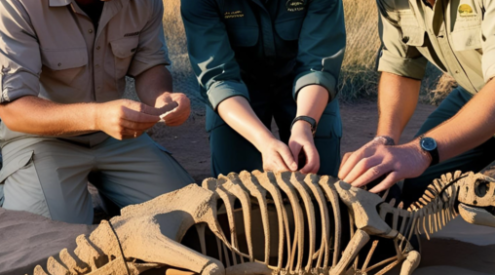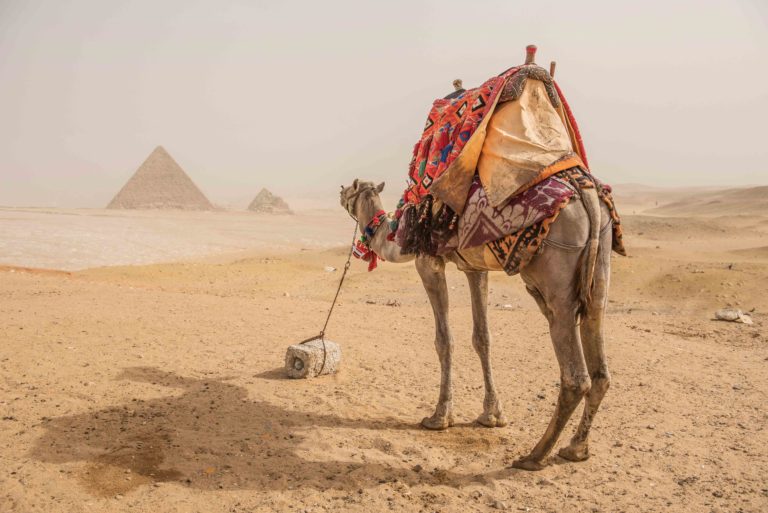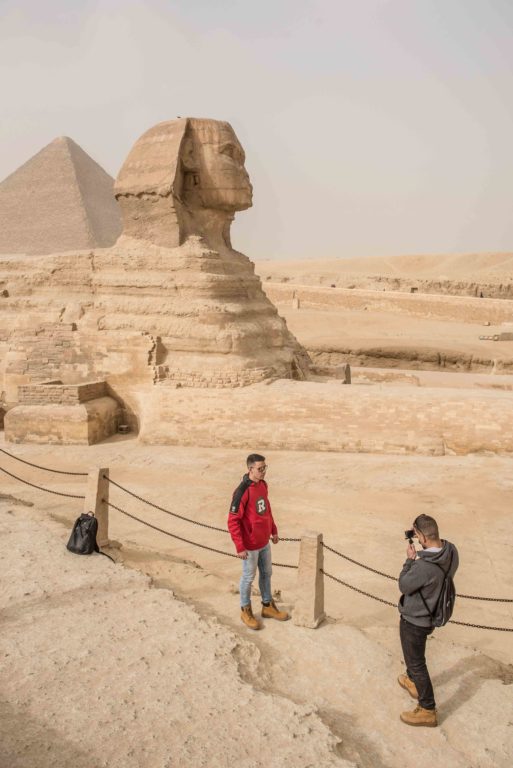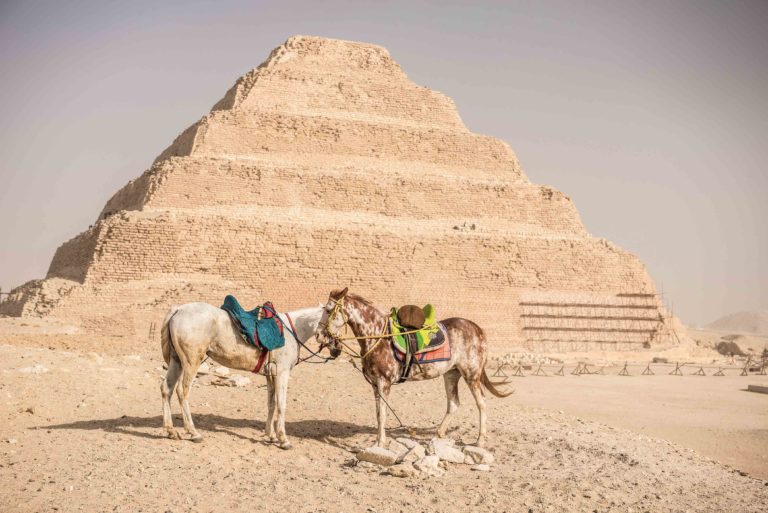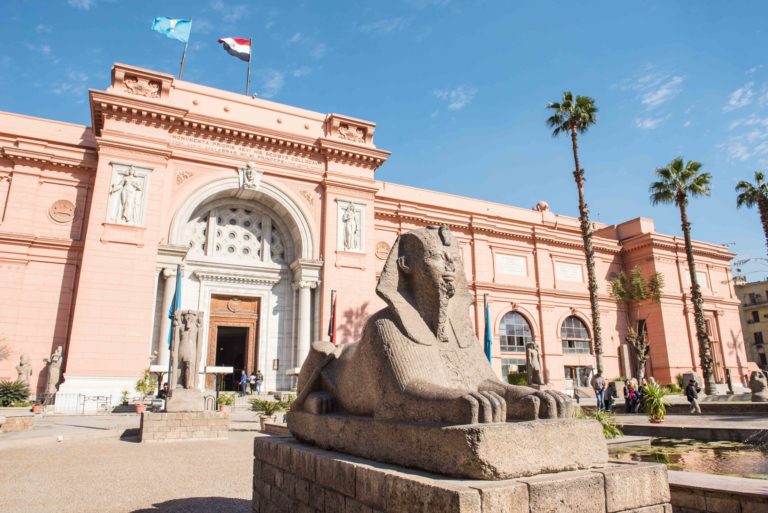It was sunset in midwinter Cairo. The city of 23 million souls was the colour of the desert, its skyline pricked with countless minarets. We threaded our way through apocalyptic traffic, across a mercury Nile, through avenues of Soviet-style high-rises and into Giza, the ancient realm of the dead. Turning a corner, they were suddenly before us. Incongruous, overpowering. Three monstrous triangles of stone.
Our group had come to Giza for the nightly sound-and-light show. Finding our seats in an open-air plaza overlooking the site, we waited for darkness. Then, with lasers and lights, we traced the history of the pyramids: the rising and falling of Nile waters, of dynasties, of civilisations. Alexander the Great and Cleopatra, Caesar and Napoleon, all gazed upon this place in awe.
Glowing in multicolour, the monuments oozed mystery. We learnt how they were built and when, but so many questions remained. ‘Man fears time, but time fears the pyramids,’ boomed the BBC-accented voice over the loudspeakers.
The next morning our small group of travellers was up early for a journey even further back in time: to the very origins of the pyramid concept. Our minibus drew up in a windswept, desert parking lot south of the city.
Bent against the wind and stinging sand, we made our way into Saqqara’s Step Pyramid complex, hounded by insistent trinket sellers and touts (a situation that persisted throughout our Egyptian travels). Saqqara was the necropolis for the city of Memphis and remained a burial ground for more than 3,500 years. It’s Egypt’s largest archaeological site.
Most of Saqqara was buried under sand until the mid-19th century, when French Egyptologist Auguste Mariette made his first discoveries there. The Step Pyramid complex was not exposed until 1924, and it’s still in a constant state of restoration.
We entered Pharaoh Zoser’s funerary compound via a hypostyle hall. The corridor was lined with 40 ‘bundle columns’, ribbed to resemble palm or papyrus stems. The hall led us to the Great South Court. We emerged into sunlight and gazed upon the world’s oldest pyramid.
‘This is where it all begins,’ said our guide, Mohamed ‘Dino’ Radwan. ‘In the year 2 650 BC, Zoser asked his chief architect, Imhotep, to build him a Step Pyramid. It’s 60 metres tall and the whole funerary complex is enclosed by a 1 645-metre‑long limestone wall.’
Dino explained how previous temples had been constructed from perishable materials, while royal tombs were usually underground rooms topped with a mastaba – a mudbrick structure in the shape of a bench. However, Imhotep developed the mastaba into a pyramid by placing ever smaller mastabas on top of each other in steps … and he built it in hewn stone encased in fine white limestone. From his innovation flows so many of Egypt’s later architectural achievements.
‘This is where the very idea of a pyramid is born,’ said Dino. ‘Now that you’ve seen the origins, let us revisit the greats.’
We piled into the minibus and headed north, back to Giza. Reaching the site, the sandstorm had built up a head of steam and we took shelter behind a wall next to the Great Pyramid of Khufu.
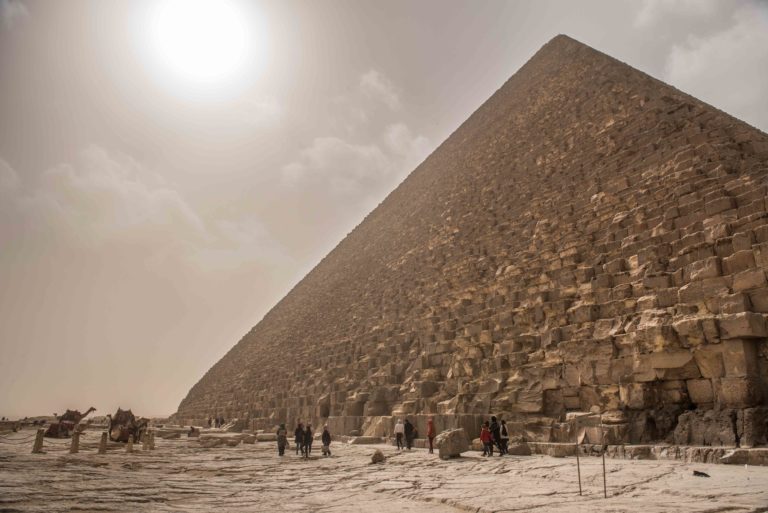
The Great Pyramid of Khufu is the oldest and largest of the three pyramids in the main Giza complex.
Dino shouted against the wind: ‘It stood 146 metres high when it was completed around 2 570 BC. After 46 centuries, its height has been reduced by nine metres. Built from 2,3 million blocks of stone and weighing six million tons, Khufu’s pyramid is truly great. The Giza complex contains three pyramids, all of them tombs for the pharaohs constructed by thousands of workers. Today they stand as a tribute to the power and organisation of Ancient Egypt.’
We stood before Khufu’s colossal structure. Ancient, overbearing, snubbing its nose at time, the monstrous thing rose out of the desert as humankind’s first major, structural achievement. Stripped of its polished limestone, scratched with graffiti and damaged by earthquakes, it’s still magnificent. As radical ideas go, this has hardly been surpassed in the last 4,000 years.
We wandered about the site as the gale whipped sand flurries into the air. Camels hunkered down looking miserable, a horse broke free and galloped over a dune. Even the trinket sellers and baksheesh (tip) hunters were subdued.
Dino led us to the second pyramid, belonging to Pharaoh Khafre. We joined a queue and entered a portal. A long, claustrophobic passage led down and then up into the heart of the structure. The air grew muggy, my breath shorter. We reached the burial chamber. All its treasures had long since been looted, but the pharaoh’s sarcophagus was still there.
I thought of the thousands of tons of stone above my head, pressing down on this chamber, the final resting place of Khafre’s mummy. I thought, too, of the grandiose promise of the afterlife and the riches that this place once contained. All gone.
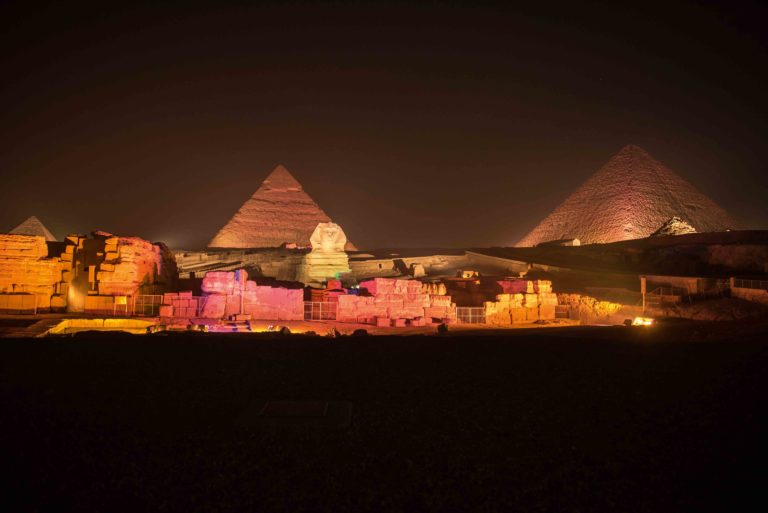
Giza’s nightly sound-and-light show provides a spectacular journey through the ages, tracing the history of this famous site. Image: Justin Fox.
Feeling light-headed, I made it back to the land of the living and headed down the hill to the Sphinx, ancient guardian of the pyramids. Giza’s feline enigma sat in its pit, paws outstretched, muscular leonine body carved from stone and a face upon which so many have gazed and wondered.
Known in Arabic as Abu al Hol (Father of Terror), this sculpture of a man with the body of a lion was dubbed the Sphinx by the Ancient Greeks because it resembled their mythical winged monster who set riddles and killed anyone unable to answer them. A geological survey has shown that it was most likely carved from the bedrock at the bottom of the causeway during Khafre’s reign, so the head probably portrays his features.
In the foreground were hordes of selfie-crazed tourists, holding their phones aloft and striking poses. Some simulated kissing the Sphinx, or hugging it, or tickling its chin. So obsessed were they by their Instagramming that they failed to appreciate, or even notice, the giant man-cat behind them. The implacable creature had, of course, seen it all before and continued to ignore us with the disdain we deserved, as it had for four millennia.
Egyptian Museum
After visiting the pyramids, set aside at least half a day to explore downtown Cairo’s Egyptian Museum (entry is R122* pp). This vast repository is home to more than 120,000 artefacts from Ancient Egypt (statues, mummies, jewellery, eating utensils, toys), including the treasures and gold burial mask of Tutankhamun. Most objects are still on display, although some are in the process of being moved to the Grand Egyptian Museum, Giza, scheduled to open later this year.
Plan your trip
Getting there
I flew to Cairo with Egypt Air (code sharing with SAA) from Joburg. From R7,000* return. egyptair.com
About the tour
I travelled to Egypt with On the Go Tours. The tours are escorted by guides qualified in Egyptology, and stays are in four- or five-star establishments. My nine-day, ‘King Tutankhamen’ tour included Cairo, the Step and Giza pyramids, the Sphinx, Egyptian Museum and a Nile cruise from Aswan to Luxor. Included in the price are eight breakfasts, two lunches and three dinners and all transfers. From R14,900* pp sharing. 0800-990-311, onthegotours.com
Do this
Visit the pyramids early in the morning or late afternoon to avoid the crowds. Entry is R122* (plus there’s a fee for some of the museums and pyramids within). Follow the road past the pyramids to reach a plateau for the best panoramic view of the site. Hire a camel or horse-drawn cart to see the pyramids from the desert; agree on a price before you set off. Beware, the touts and trinket terrorists are mercenary here!
Need to know
SA passport holders require a visa. I got mine from the Egyptian Embassy in Pretoria using Visa Request (service fee R350*, courier R240*). visarequest.co.za.
*Prices subject to change
This post is adapted from an article first published in the April 2019 issue of Getaway magazine.
Get this issue →
All prices correct at publication, but are subject to change at each establishment’s discretion. Please check with them before booking or buying.




